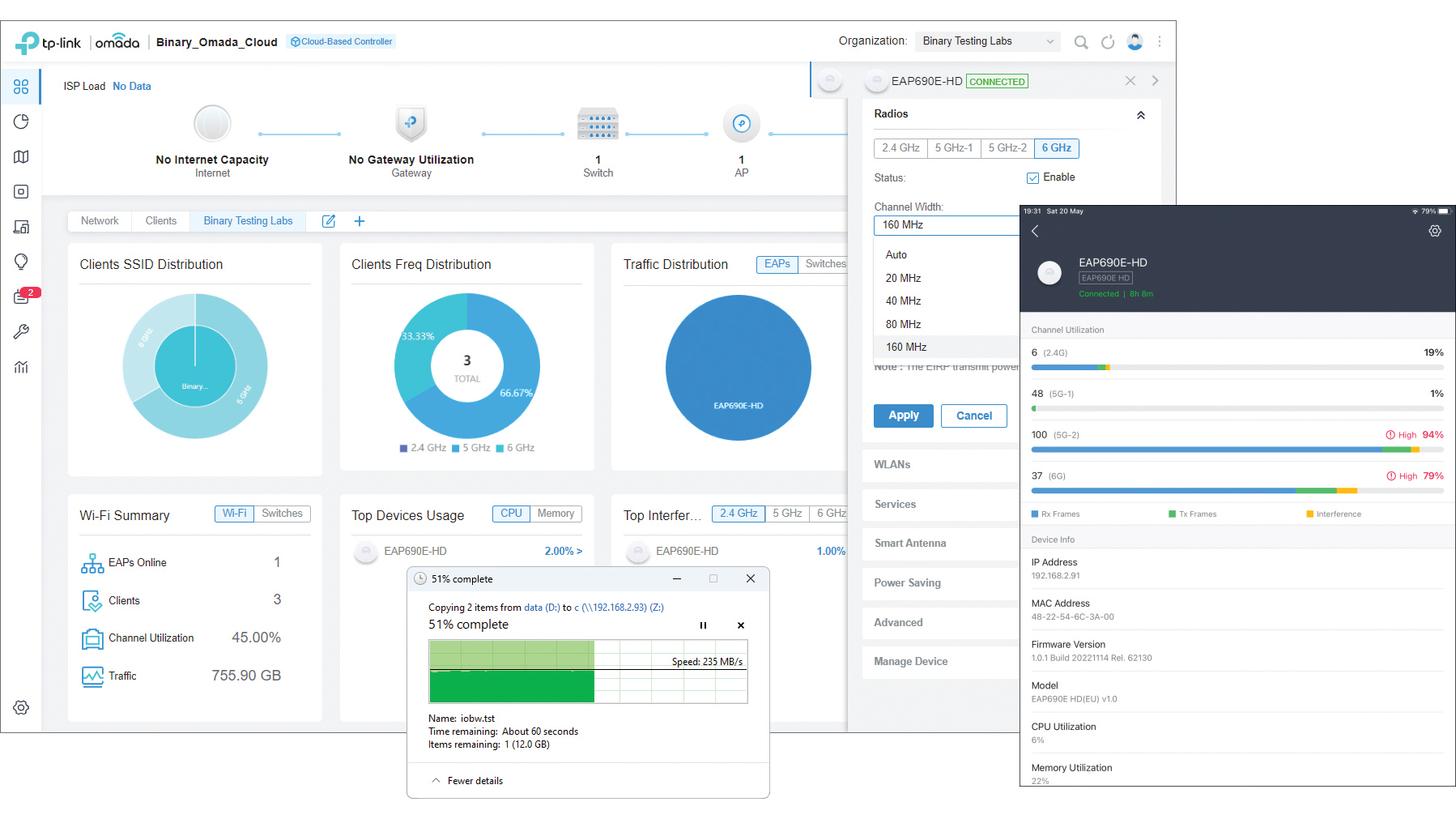TP-Link Omada EAP690E HD review: All a business needs to satisfy high-density wireless network plans
Great performance and slick cloud management make this Wi-Fi 6E AP perfect for high-density networks

-
+
Great cloud management
-
+
Impeccable wireless performance
-
-
None

TP-Link takes a commanding lead in the business wireless AX class wars, with the Omada EAP690E HD being the first AXE11000 access point (AP) to market. Its mighty Wi-Fi 6E unit achieves this admirable feat by delivering quad-band wireless services comprising 2.4GHz, dual 5GHz, and 6GHz radios.
All four radios can be enabled simultaneously and deliver claimed maximum speeds of 1,148Mbits/sec on the 2.4GHz radio, 2,402Mbits/sec on each 5GHz radio, and 4,804Mbits/sec on the 6GHz radio, with the latter supporting the Wi-Fi 6 160MHz channels. That's a lot of bandwidth to cram through the AP's LAN connection, and TP-Link claims another first with the EAP690E HD sporting a high-speed 10-gigabit (10GbE) port.
TP-Link Omada EAP690E HD review: Setup
The LAN port supports an 802.3at PoE+ power source, and to get the best from it you'll need a switch that can provide this over a 10GbE connection; for testing, we used Zyxel's XS1930-12HP 10GbE multi-gigabit PoE++ switch. If you don't have a suitable PoE+ source that's fine, as TP-Link includes a power adapter in the box.

You can manage the AP as a standalone device, but TP-Link's Omada cloud service will be the preferred choice for most businesses as they can keep a close eye on all their APs and other Omada-enabled switches and routers from one central web portal. There are plenty of choices, too: you can install TP-Link's hardware or free software controller on-site; or use its cloud-based controllers, with yearly prices starting at £12 exc VAT per device.
We swapped over to a cloud controller a while ago as it's easier to use and provides zero-touch provisioning for fast device deployments to remote offices. From our main Omada portal account, we chose our cloud controller and imported the AP by entering its serial number, naming it, and assigning a license.
Once adopted, all access to its local web console was disabled and it started broadcasting our site-managed SSIDs. The controller portal presents a detailed dashboard that can be customized with widgets, and we added ones to show details such as AP traffic and client distributions, the most active APs, a Wi-Fi summary, and 24-hour graphs of client associations and overall wireless traffic.

The EAP690E HD is great for high-density wireless environments, as it can handle over 2,000 clients and each radio supports eight SSIDs so you can present up to 32. Each can have their own mixed WPA2/WPA3 encryption, global or per client and SSID upload and download rate limits and guest networks to prevent users from accessing private networks.
They can also present captive portals using profiles to apply a global password, local user, voucher, Radius, or Facebook authentication, and add custom pictures, logos, greeting messages, and acceptable use policies (AUPs).
Another bonus of cloud management is the option to enable meshing to quickly extend your wireless network coverage. We set the AP to broadcast one SSID with all four radios enabled and tested 5GHz speeds with a Dell Windows 10 Pro workstation equipped with a TP-Link Archer TX3000E Wi-Fi 6 PCI-E adapter. Using the 80MHz channels, large file copies between the workstation and a 10GbE-connected Windows server delivered close-range speeds of 115MB/sec, dropping to 99MB/sec with the AP moved ten meters away into an adjoining room.
A Dell Windows 11 Pro workstation connected to the 6GHz radio using a TP-Link Archer TXE75E Wi-Fi 6E PCI-E adapter produced a big performance boost over the 160MHz channels, with close range copies averaging 233MB/sec and 187MB/sec at a distance of ten meters. We increased the pressure by running Iometer on both workstations connected to the same mapped share on the server and saw a cumulative write throughput of 283MB/sec, with the portal reporting AP CPU utilization of only 6%.
TP-Link's Omada EAP690E HD has what it takes to satisfy businesses planning on serving up high-density wireless networks. This AXE11000 AP has a radio for every occasion, delivers impeccable wireless performance, and offers plenty of enterprise-class features at an SMB price.
TP-Link Omada EAP690E HD specifications
| Band support | AXE11000 quad-band 2.4/2 x 5/6GHz 802.11ax |
| Radios | 16 internal smart aerials |
| Ports | 10GbE LAN/802.3at PoE+ |
| Additional features | ceiling/wall mounting plate |
| Dimensions | 280 x 280 x 59mm (WDH) |
| Weight | 2.1kg |
Get the ITPro daily newsletter
Sign up today and you will receive a free copy of our Future Focus 2025 report - the leading guidance on AI, cybersecurity and other IT challenges as per 700+ senior executives
Dave is an IT consultant and freelance journalist specialising in hands-on reviews of computer networking products covering all market sectors from small businesses to enterprises. Founder of Binary Testing Ltd – the UK’s premier independent network testing laboratory - Dave has over 45 years of experience in the IT industry.
Dave has produced many thousands of in-depth business networking product reviews from his lab which have been reproduced globally. Writing for ITPro and its sister title, PC Pro, he covers all areas of business IT infrastructure, including servers, storage, network security, data protection, cloud, infrastructure and services.
-
 ‘Phishing kits are a force multiplier': Cheap cyber crime kits can be bought on the dark web for less than $25 – and experts warn it’s lowering the barrier of entry for amateur hackers
‘Phishing kits are a force multiplier': Cheap cyber crime kits can be bought on the dark web for less than $25 – and experts warn it’s lowering the barrier of entry for amateur hackersNews Research from NordVPN shows phishing kits are now widely available on the dark web and via messaging apps like Telegram, and are often selling for less than $25.
By Emma Woollacott Published
-
 Redis unveils new tools for developers working on AI applications
Redis unveils new tools for developers working on AI applicationsNews Redis has announced new tools aimed at making it easier for AI developers to build applications and optimize large language model (LLM) outputs.
By Ross Kelly Published
-
 Google layoffs continue with "hundreds" cut from Chrome, Android, and Pixel teams
Google layoffs continue with "hundreds" cut from Chrome, Android, and Pixel teamsNews The tech giant's efficiency drive enters a third year with devices teams the latest target
By Bobby Hellard Published